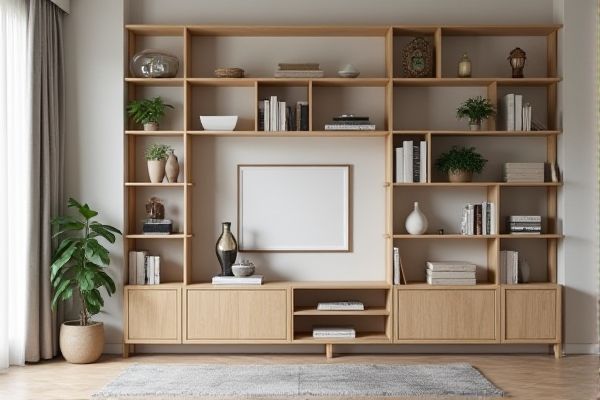
Removable shelves offer greater flexibility by allowing you to adjust storage space according to your needs, while fixed shelves provide more stability and support for heavier items. Discover which shelving option best suits your space and lifestyle in the rest of this article.
Table of Comparison
| Feature | Removable Shelves | Fixed Shelves |
|---|---|---|
| Flexibility | High - shelves can be repositioned or removed | Low - shelves are permanently attached |
| Customization | Allows adjusting shelf height to fit items | Limited; predetermined spacing |
| Installation | Usually easier to assemble and modify | Often requires precise installation and is fixed |
| Durability | Moderate; may wear with frequent adjustments | Generally sturdy and stable |
| Cost | Typically slightly higher due to mechanisms | Usually more cost-effective |
| Use Case | Ideal for variable storage needs and changing items | Best for consistent storage solutions |
Introduction to Removable and Fixed Shelves
Removable shelves offer the flexibility to customize your storage space by easily adjusting shelf height or configuration, making them ideal for dynamic environments. Fixed shelves provide sturdy, permanent storage solutions that maximize stability and are well-suited for heavy or consistent loads. Understanding the differences between removable and fixed shelves helps you choose the best option for your specific organizational needs.
Key Differences Between Removable and Fixed Shelves
Removable shelves offer flexibility by allowing you to adjust or relocate storage space according to your needs, making them ideal for varying item sizes and easy cleaning. Fixed shelves provide sturdy, permanent storage with enhanced weight support and structural stability, suitable for heavy or frequently used items. Choosing between removable and fixed shelves depends on your preference for adaptability versus long-term durability in organizing your space.
Installation Process Comparison
Removable shelves feature a straightforward installation process involving simple brackets or clips, allowing for easy adjustment and repositioning without requiring tools or structural modifications. Fixed shelves demand a more permanent installation, often secured with screws or nails directly into wall studs, providing enhanced stability but limiting flexibility in shelf placement. Choosing between the two depends on the need for versatility versus structural strength in storage solutions.
Flexibility and Customization Options
Removable shelves offer superior flexibility and customization options by allowing you to adjust shelf height or configuration to accommodate items of varying sizes easily. Fixed shelves provide stability but limit adaptability, making it harder to rearrange storage space according to changing needs. Choosing removable shelves enhances your ability to optimize storage layout and tailor organization to specific requirements.
Durability and Maintenance
Removable shelves offer flexibility for cleaning and easier replacement, enhancing maintenance convenience but may sometimes sacrifice long-term durability due to adjustable fittings. Fixed shelves provide superior structural stability and are generally more durable over time, with fewer components that can wear out or loosen. Your choice depends on balancing the need for easy upkeep against the desire for lasting sturdiness in shelf construction.
Space Efficiency and Organization
Removable shelves offer enhanced space efficiency by allowing customization of shelf height to accommodate items of varying sizes, optimizing storage capacity in closets and cabinets. Fixed shelves provide stable support but limit flexibility, often resulting in wasted vertical space when stored items do not fit perfectly. Adjustable shelving systems improve organization by enabling tailored arrangements, making it easier to categorize and access belongings effectively.
Cost Comparison: Removable vs Fixed Shelves
Removable shelves typically incur higher initial costs due to adjustable hardware and increased material requirements, while fixed shelves are more cost-effective with simpler construction and installation processes. Maintenance expenses for removable shelves can be higher over time as adjustable components may wear out or need replacements, whereas fixed shelves generally require less upkeep. Budget-conscious projects often favor fixed shelves for their affordability, but removable shelves offer long-term flexibility that can justify the upfront investment.
Ideal Applications for Removable Shelves
Removable shelves provide flexibility in storage solutions, making them ideal for environments requiring frequent reorganization such as retail stores, warehouses, and residential closets. Their adjustable nature supports diverse item sizes and shapes, enhancing space optimization in offices and garages. This adaptability also benefits display settings where visual merchandising needs change regularly.
When to Choose Fixed Shelves
Fixed shelves provide superior stability and support for heavy or frequently used items, making them ideal for bookshelves, storage units, and display cases. They maximize structural integrity, enabling higher weight capacity and reducing the risk of sagging or collapse. Choose fixed shelves when durability and permanent configuration are critical for long-term organization and storage needs.
Conclusion: Which Shelf Type is Right for You?
Removable shelves offer flexibility, allowing easy customization for varying storage needs and making cleaning simpler, ideal for dynamic spaces or frequently changing items. Fixed shelves provide sturdiness and durability, supporting heavier loads and offering a permanent, stable structure best suited for consistent organization. Your choice depends on whether you prioritize adaptability or long-term stability for your storage requirements.
 homyna.com
homyna.com